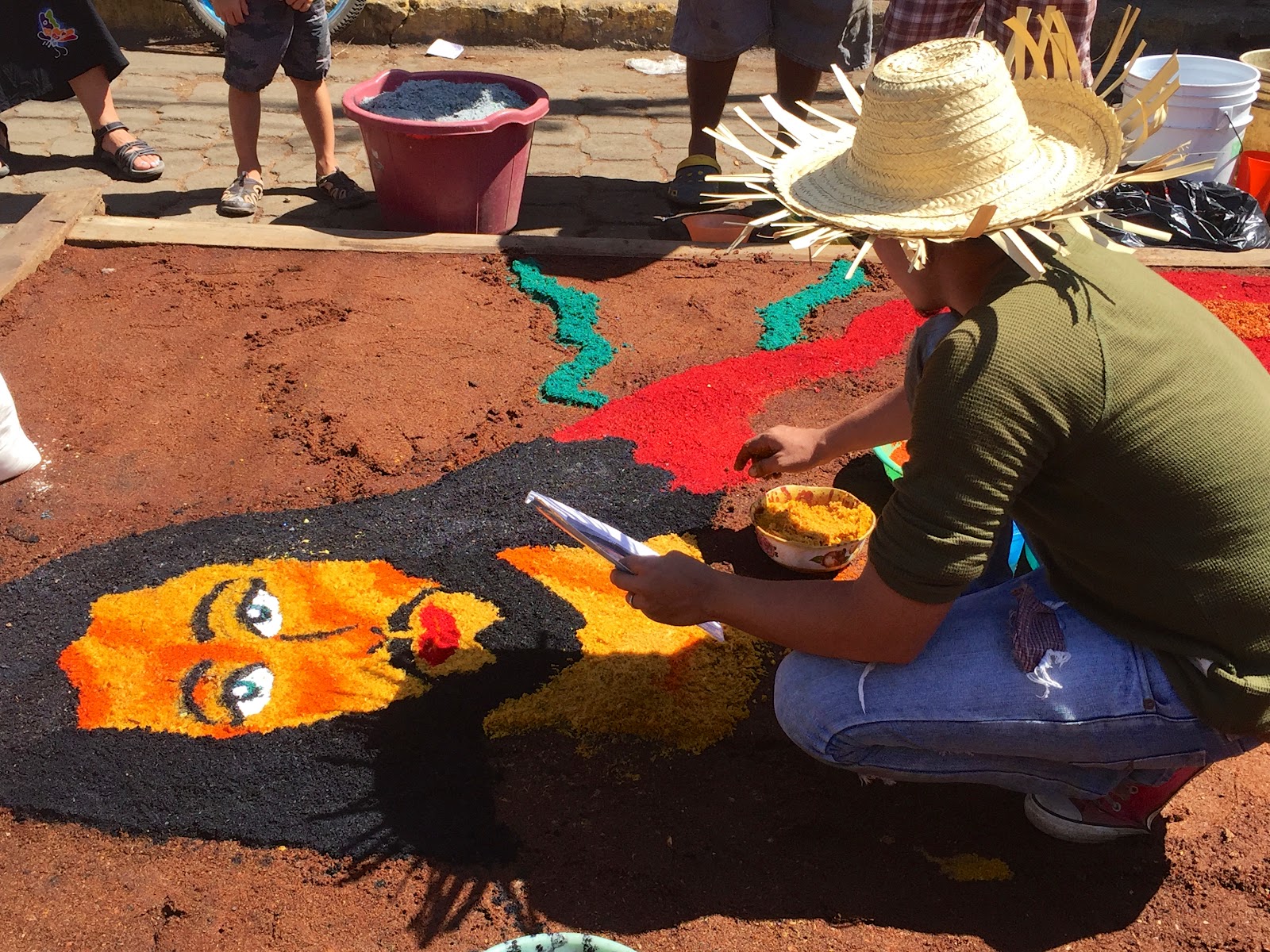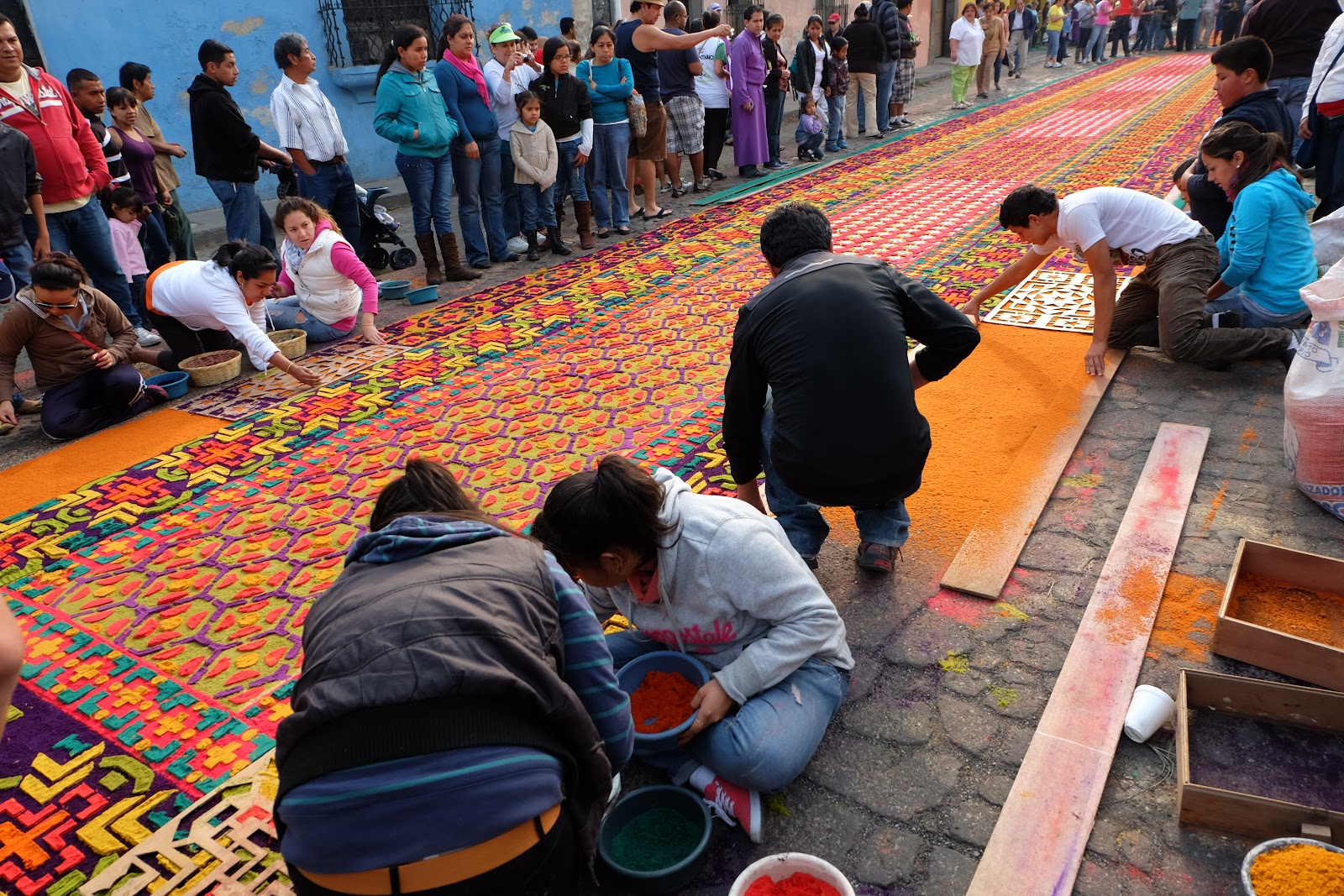 |
| Constructing a Huerto, Diria, Nicaragua |
ColonialMexicoInsideandOut
Colonial Mexico's art, architecture, churches, religious customs and history
Sunday, March 24, 2024
Nicaragua's Holy Week Gems
Monday, December 11, 2023
Guadalupe's Day
Tuesday, December 5, 2023
Fine Dining for the Dead
 |
| Hanal Pixan Altar, Izamal, Yucatán, MX 2023 |
There is one dish that is characteristic of Hanal Pixán altars that you will not find in other parts of Mexico. That is mukbil pollo which translates as "buried chicken"; the dish is also called "pibes". Mukbil Pollo is a chicken tamale wrapped in banana lives and cooked in a hole in the ground; the realm of the dead. It has a distinctive smokiness due to the way it is cooked.
The thing is that living people also like Mukbil Pollo. It has a wonderful smoky aroma and taste because of the way it is cooked-wrapped in banana leaves and cooked in an open fire underground. Several years ago, I had the dish in a restaurant in Izamal during the time of Hanal Pixan. Hoping for a repeat, I drove the three hours to Izamal from my home base in Quintana Roo, since Mukbil Pollo is generally not available commercially'. It typically s cooked in homes for the express purpose of the altars.
Arriving in Izamal, a fascinating town with a rich colonial colonial history and the beautiful 16th century monastery of San Antonio de Padua, I began my inquiries. They turned up nothing.
 ,, ,, |
| Convento of San Antonio de Padua, Izamal Yucatán |
 |
| Izamal, Yucatán |
 |
| Street scene, Izamal, Yucatán, showing monastery wall |
Finally, someone told me about a woman with a tricycle cart who sold mukbil pollo, daily, proving my point that the dish attracts the living as well as the dead. Asking as I went, I found her street and then her house. Peering in her house, I could see the pibes (same as Mukbil Pollo).
 |
| House interior, Izamal, Yucatan |
 |
| Mukbil Pollo orders for Hanal Pixán altars, Izamal, Yucatán |
 |
| Counting the orders of Mukbil Pollo, Izamal, Yucatán |
The woman was a good businesswoman and had her grand-daughter tally orders to see if there was spare for me. As she counted the orders, I decided not to to take food out of a dead person's mouth, thanked her and told her to hold onto her orders in case one was needed for a last-minute altar.
Back on the street I started, once again, making my inquiries. I was in luck- a restaurant down the block, the finest in the town, was serving mukbil pollo to living humans. I'd managed to stumble into Izamal's fine-dining establishment, the beautiful Restaurant Kinich Izamal.
Kinich's special for the day- it was November 1, the second day of Hanal Pixán- was none other than Mukbil Pollo. The portion was huge, as one is typically split by a whole family. I'm not sure if it was actually cooked in the traditional way, stuck in a fire in a hole in the ground, but it was close enough.
 |
| Restaurante Kinich Izamal |
A sizable box of left-overs in hand, I walked back to my car for the 3 hour return trip.
Wednesday, June 21, 2023
Before There Was Columbus
 |
| Prince Henry the Navigator |
We all owe this man, who you probably never heard of, a big thank you. Infante Dom Henrique, who became known as Prince Henry the Navigator (1394-1460) was the fourth child of King John I of Portugal He was to become a pivotal figure in the history of maritime exploration, credited with starting the Age of Discovery.
Fighting the Moors in the Muslim port of Ceuta in Northern Africa opened his eyes to the potential of Subsaharan trade routes. This, in turn, led to a general fascination with Africa and desire to explore its trade possibilities.
He established a School of Navigation in the furthest southwest part of Portugal, Sagres. His goals were to find new trade routes to Africa and along the way to establish alliances against Muslim power. In those days, Sagres was, literally, the end of the world. What lay to its west, no one knew. According to the legends that abounded there were sea monsters and the waters at times boiled- no one was interested in finding out if these things were true or not.
 |
| Cliffs, Sagres Portugal |
 |
| Navigational device Sagres Portugal, possibly associated with navigational school of Prince Henry |
 |
| Fort of Sagres, purported location of School of Henry the Navigator |
Henry's goal was to demystify this great body of water and set the stage for exploration. He gathered the best minds of the time in navigation, cartography, shipbuilding and other maritime disciplines. This maritime "think tank" is usually called the "Sagres Navigational School", although the exact location of this school or its precise details are not known. Local guides will tell you that the school was associated with the Fortress of Sagres, but there is no proof that this was its physical location. By report, the school was very strict and fear and superstition were not tolerated.
Enter Christopher Columbus. His interest was in sailing west across the Atlantic to Asia. Portugal saw some basic flaws in this plan ( more about that in another post) and would not support him. Spain did and the rest is history.
It has been claimed that Columbus trained at the Sagres school of Henry the Navigator. There is no proof that he was ever a student of its rigorous curriculum, but he was influenced by the climate of the intensive Portuguese exploration of the time and its advanced maritime knowledge.
Henry did not spend his time in the courts of Lisbon, but in Sagres and the great monasteries of Portugal's Estremadura region, to the north. Henry died in Sagres and his tomb is in the Batalha Monastery.
 |
| Baltalha Monastery, Portugal |
 |
| Tomb of Henry the Navigator, Batalha Monastery, Portugal |
Henry, himself, did not sail, but without him, his school, and support of maritime exploration, who knows if Columbus would have reached the New World (even if he was actually looking for India).
Thursday, April 6, 2023
A One of a Kind Easter Celebration
A hooded man with a whip may not seem very much like Easter, but in many places in the historical Latin American and Spanish worlds, it was. The time before Easter was a penitential time in which people attempted to purge themselves of their sins to ready themselves for the joy of Christ's resurrection on Easter Day. Flagellation, self-whipping to cause pain, was one way.
A completely unique twist on this ancient practice is still found in Nandaime Nicaragua on the Wednesday before Easter. I had the privilege of viewing (and, unanticipatedly, feeling) his event first-hand. Here is this link to the article.
https://colonialmexicoinsideandout.blogspot.com/2016/04/taking-hit-holy-wednesday-in-nandaime.html
Sunday, December 11, 2022
The Feast of Guadalupe Returns Full Force
 |
| Lighted image of Guadalupe, Akumal MX |
In 2020 and 2021 all activities in Mexico, including religious ones, were limited because of the pandemic. This year they have mostly returned to their pre-covid form, including the feast of Guadalupe patron saint of Mexico. There are some new regulations such as the requirement to wear masks inside Guadalupe's main basilica in Mexico City, but the traditional observances are back. The return of this beloved celebration is expected to draw record crowds, which does pose logistical problems, as laid out in these two articles.
The period right before December 12, the feast day of Guadalupe is a spiritually intense as well as busy one, as pilgrims rush to reach their destinations by the night of December 11.
 |
| Car of a Guadalupe pilgrim in Yucatán |
 |
| Guadalupe pilgrims at a stop along route in Quintana Roo, MX |
https://colonialmexicoinsideandout.blogspot.com/2017/02/guadalupe-in-paradise.html
https://colonialmexicoinsideandout.blogspot.com/2017/12/the-race-for-guadalupe.html
Friday, April 15, 2022
Semana Santa is Back
Building Sawdust Carpets, Antigua Guatemala
 |
| Procession, Antigua Guatemala |
 |
| Good Friday Procession, Leon Nicaragua |
 |
| Sawdust Carpet under construction, Leon Nicaragua |
One of a kind Holy Wednesday tradition rooted in medieval penitential practices: https://colonialmexicoinsideandout.blogspot.com/2016/04/taking-hit-holy-wednesday-in-nandaime.html






